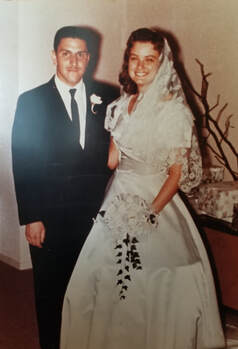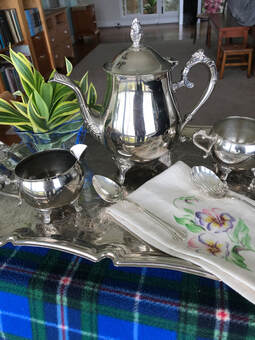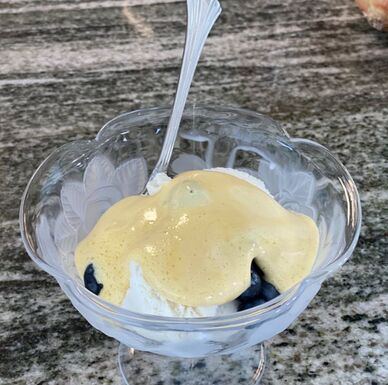During these times of historic cultural change simultaneous with the continuing spread of the corona virus, the communal celebrations we once expected in the spring and summer months are no longer with us. Easter has come and gone along with Mother’s Day and Father’s Day, with only the smallest gatherings allowed. Weddings have been postponed, and students have missed their own graduations. And sadly, many of us have lost loved ones.
My precious sister Margaret died at the end of May, and we have still not been able to arrange a family memorial service for her. I wrote this poem seven years ago when her illness was first diagnosed.
| We Three February 13, 2013 We walk in her tiny garden And cut figs from the tree. Her quince still looks dead and stick-like, But she says it will bloom soon; The red blossoms will come out Even in winter’s chill. We three old siblings reach up high To pick last year’s sweet oranges And peel them in the yard, Juice dripping on our fingers As our heads form a tight triangle In the pale sunlight. We three are at ease as we were in childhood, More than six decades ago, Uprooted and clinging to one another With a secret bond shared with no one else. And none of us mentions That tomorrow she will not remember That her brother and sister were here. |
Margaret Frances Murdock Pedulla was a brilliant woman and my sister. Her life-long passion was reading, and our middle brother John and I were her first students. Although she herself was only three and a half years older than I, she taught John and me to read before we started kindergarten, and all three of us have loved books all our lives. But Margaret was the star. In the summers, when school was out, we all joined the vacation reading club at the library. The librarians would create an impressive looking chart with the names of all the children in the book club, and we would each earn, yes, a gold star for each book we read.
Margaret earned approximately twenty stars for every star the rest of us could manage. And she read so quickly that she would walk to the library by herself in between our family visits and return with her arms loaded with a new supply of books while Johnny and I were still working on the first book we had selected. When our parents finally bought her a bicycle, she was in heaven, as she could make daily trips to the library and fill her basket with books to take home after spending the afternoon reading encyclopedias, atlases and unabridged dictionaries. She was an invaluable asset for me and John during our pre-Google school years, as our sister knew the answer to even the most obscure question and could spell and define any word in the English language, happy to share her knowledge without the slightest hint that her siblings were somehow deficient.
I will share just one example of Margaret’s astonishing commitment to reading. Early in my career as a college English instructor, I was assigned to teach a Survey of British Literature class, covering the Neoclassical, Romantic, Victorian and Modern eras. The first writer on the syllabus was John Dryden, who lived from 1631 to 1700 and wrote prolifically as a poet, literary critic, translator and playwright. Dryden’s dramatic works alone included thirty tragedies, comedies, and dramatic operas. And his numerous poems and works of social commentary were notoriously lengthy. As I was planning the reading list for the semester, I asked Margaret if she had ever read anything by Dryden. She paused for a moment and said, “Well,” then paused again as though she were thinking; then she replied matter-of-factly, “I’ve read everything he ever wrote several times.”
Margaret’s reading interests were indeed eclectic. As a child, she read all fourteen of the Oz books by L. Frank Baum and of course Mary Poppins and The Wind in the Willows, but she soon moved on to large novels read by our parents and grandparents—things like the complete works of Charles Dickens and all of Jane Austen’s Novels. While still in high school, Margaret became fluent in Spanish, a transformation that seemed miraculous to me. Although she did take Spanish classes, her acquisition of the language far outdistanced all of the other students, and almost immediately she was reading Don Quixote and other Spanish classics in the original.
The year after her graduation, when I showed up at the same high school for my first Spanish class, the teacher, as he was calling the roll, stopped, stared straight at me and inquired, “Are you as smart as your sister?” Without blinking, I looked him in the eyes and replied, “No I am not!” This is what saved me. And to her credit, Margaret was a remarkably humble person in spite of her genius. She was incredibly kind to me, always generously willing to share her clothes and toys, which she didn’t want to play with anyway, and never interested in competition or criticism. She sailed through college in three years, Suma Cum Laude, and eventually earned her Masters’ Degree in Spanish Translation from the Monterey Institute of International Studies.
As you may have guessed, my sister was an introvert and certainly not a social butterfly. She had zero interest in jewelry, cosmetics, fashion trends or status of any kind. And she was utterly without vanity. What saved her in the realm of human society was her almost sixty-year marriage to Rudy Pedulla, a super extrovert and a good-hearted man who had the wisdom to accept my sister exactly as she was. To learn more about Rudy, our family patriarch, you can read my December 2019 blog, “Holiday Homage,” which honors Rudy and contains Margaret and Rudy’s lovely wedding portrait.
Margaret and Rudy settled in Watsonville, California, where Rudy taught history at Watsonville High School for thirty-five years. He became chair of the Social Studies Department and worked tirelessly to improve public education as an active member of the American Federation of Teachers. He is an accomplished home wine maker and became a wine judge at the Monterey County Fair. Margaret took an interest in our Irish and Scottish family heritage, learning to play the bagpipes and attending the Scottish Games in various locations throughout California. And as a nod to Rudy’s heritage, she taught herself Italian. Appropriately, Margaret served as Director and Coordinator of the local Adult Literacy Program. She also worked as a translator and interpreter in the Spanish speaking immigrant community surrounding Watsonville.
Rudy and Margaret’s children, Peter and Kathleen, grew up in Watsonville, where Peter still lives with his wife Tiffany, and the Pedulla grandchildren, Amanda and Molly, as well as great-grandson Finn, also live in Watsonville. My niece Kathleen is the co-author of our website: myteaplanner.com and she writes the monthly blog, “Cakes and Tea,” on this website. Margaret’s recipe for Irish Soda Bread appears in the March St. Patrick’s Day menu in “The Tea Book” section of myteaplanner.com. As a wife and mother in a small California farming community, Margaret was an extraordinary person living what appeared to be an ordinary life. Yet her fierce passion for learning and literacy, her lifetime vocation, never wavered.
Margaret was never very interested in giving or receiving gifts, but almost all of the gifts she gave to me over the years were, not surprisingly, books. For my birthday in 1995, Margaret and Rudy gave me a bi-lingual edition of the writings of the brilliant Seventeenth Century Mexican poet, dramatist and prose writer, Sor Juana Ines de la Cruz. This shining light of the Spanish Golden Age was also the first feminist writer published in the New World. A contemporary of John Dryden, Sor Juana wrote Respuesta a Sor Filotea, advocating the importance of education for women at a time when very few women in England were even taught the alphabet. Sor Juana (Sister Juana) became a nun at the age of sixteen and spent all of her adult life cloistered at the Convent of San Geronimo (St. Jerome, the patron saint of translators,) in Mexico City. At the convent, Juana had access to a library, and while there, she amassed an extensive library of her own, spending hours, days and years reading and writing.
Sometimes we find our soul sisters in other countries and even in different centuries. As a tribute to my dear sister Margaret, whom I already miss terribly and will always love, I would like to share the first quatrain of a sonnet Sor Juana wrote on the death of Laura, “…that most excellent lady, the Marquesa de Mancera.” In this translation by Alan S. Trueblood, I am taking the liberty of changing the name Laura to Margaret:
I know I am not alone during these days of social change and unrest, in longing to contribute in some way to a memorial service for my sister. Many other families have lost loved ones in the tumultuous spring and summer of 2020. Perhaps circumstances are forcing us to re-invent what a funeral or celebration of life might be. Maybe we can count on the old traditions to lift us up and show us how to say goodbye to a loved one in a smaller, more intimate way. When my mother died, ten years ago, her funeral reception was an Afternoon Tea masterminded by Kathleen and her friends. Why not have a few small gatherings, rather than one large one? Perhaps just the spouse and children of the deceased person could come together in a dignified, ceremonial way to share their love for the one who has passed away. Or a small circle of friends could offer Afternoon Tea in memory of their dear companion.
Though it has not yet happened, it comforts me to imagine an Afternoon Tea for my sister, focusing on the things she loved, to help a few of us remember and offer thanks for all that was good in her. I would include her favorite colors—green, especially pine green from the winter landscape, and deep garnet red, the colors of tartans, and her favorite music, Mozart’s The Magic Flute, (which of course she memorized,) bouquets of all the same flowers, like lilies, aromas with only a single scent, and dark chocolates, lots of dark chocolates—she loved See’s nuts and chews.
If you wish to host a small memorial gathering for someone you love, the age-old framework of Afternoon Tea already exists to help you plan an event that will be small, quiet, safe and consoling. Your memorial tea could be as simple as having a few friends over for savories, scones and sweets with each guest invited (but not pressured) to share a memory as everyone shares tea. You could add a slightly more formal tone by placing a photograph of the deceased person as a focal point in the tea room and playing music that the “guest of honor” loved as the gathering begins, although music should not be played throughout the event, as it will detract from the conversation. If the guests share religious or spiritual values, you could ask various participants in advance to select a short scripture passage, prayer or poem to read after all the guests have arrived. And the food and table settings will reflect the interests and preferences of the deceased loved one. For my sister Margaret’s memorial Tea, I will certainly serve deviled eggs, the Murdock family’s favorite comfort food, along with some simple and elegant Scottish shortbread, accompanied by Martinelli’s Sparkling Cider, produced for more than a hundred years in Watsonville, California. And as a tribute to the decades-long bond of friendship and love between the Murdock and Pedulla families, I offer an adaptation of an Italian classic: Irish Zabaglione.
Zabaglione is an ethereal dessert from northern Italy containing only three ingredients—sugar, egg yolks and a small amount of sweet wine, traditionally Marsala, named for the town in Sicily where it is produced. This light and luscious concoction, with the soft smooth texture of marshmallow crème, can be eaten with a spoon or poured over ice cream or fresh fruit as a topping. Zabaglione is ridiculously easy to make and can be whipped up and ready to serve on the spot.
My husband and I first encountered Zabaglione back in the day when we used to drive up to Lake Tahoe and dine at the Summit restaurant on the top floor of Harrah’s Hotel. In this rarified space, the immaculately trained waiters would roll their serving carts next to the booths and hand whip the sugar, egg yolks and Marsala in a copper bowl over a burner, using only the strength and expertise of their own wrists, until the concoction reached the perfect volume and texture. Then they would construct a spectacular Coupe de Vario, (gourmet sundae,) by pouring the warm Zabaglione into delicate crystal dessert dishes filled with vanilla ice cream and pieces of chopped fresh fruit such as pineapple or oranges or seasonal berries. Why doesn’t everyone make Zabaglione at home all the time? The answer is simple. There is a very fine line between perfect Zabaglione and Sweetened Scrambled Eggs.
I regained my courage to make Zabaglione when my husband Wayne gave me an electric whisk, which also has an immersion blender attachment. This magical tool, made by Breville, has liberated me to create all kinds of culinary wonders that I was either too lazy or too intimidated to make on my own. We decided to make Zabaglione recently while sheltering at home out here in rural Hawaii during the corona virus. It was late Friday afternoon, and a quick look in the cupboard revealed no Marsala in sight. We are not drinkers, and all we had was some rum left over from the Christmas fruitcakes. Undaunted, we donned our masks, and with our dog in tow, we hiked over to the Seven-Eleven, the only store of any kind in the village of Kaaawa where we live.
The parking lot was full of trucks with local guys buying their weekend beer. The dog and I waited outside while Wayne headed for the liquor aisle. No Marsala. No Amaretto. The only sweet liqueur in the Kaaawa Seven-Eleven was Bailey’s Irish Cream, locked up in a cabinet. This is how Irish Zabaglione was born.
For the Zabaglione:
- 8 extra-large egg yolks
- ½ cup granulated sugar
- ¼ cup Bailey’s Irish Cream
For Coupe de Vario:
- Vanilla Ice Cream
Fruit and Flavoring Options:
- Fresh Berries (We used blueberries. Raspberries or sliced strawberries would also be good.)
- Brandied Cherries
- Toasted Sliced Almonds
- Dark Chocolate Shavings
- Diced Fresh Oranges
- Diced Fresh Pineapple
Special equipment: large metal mixing bowl, electric whisk (or hand-held whisk or electric mixer), double boiler (or a medium sized saucepan) rubber spatula
Makes: 8-12 servings (recipe can be cut in half to make 4-6 servings)
- Place a few inches of water in the bottom of a double boiler or medium sized saucepan. Turn the heat to medium and bring the water to a simmer. Turn the heat to low as the water continues to simmer.
- Separate 8 extra-large eggs and place the yolks in a large metal mixing bowl or the top of a double boiler. (Save the egg whites for another use such as a Pavlova, meringue cookies or egg white omelettes.) Add ½ cup sugar to the egg yolks and beat with an electric whisk for 4 four minutes. (If using a hand whisk, beat until the mixture doubles in volume and has turned pale yellow.)
- Add ¼ cup of Bailey’s Irish Cream, and place the mixing bowl over the simmering water, making sure that the water does not touch the bottom of the bowl, continuing to whisk as you do so. Your goal is to create steam which will warm the egg yolks, but the egg yolks should not actually cook.
- Beat the mixture over the simmering water for 4 minutes, watching carefully for any signs that the egg yolks are starting to scramble. Move the whisk around all sides of the bowl during the beating process. Remove from the heat and serve immediately warm in dessert bowls with spoons.
- To create Coupes de Varios, place one or two scoops of vanilla ice cream in individual dessert dishes, add berries or fresh fruit, pour Irish Zabaglione over the ice cream and top with toasted sliced almonds and or dark chocolate shavings. Serve immediately.
Note: Zabaglione can be refrigerated, and it is just as delicious cold. You can make it a couple of days before you want to serve it and keep it covered in the fridge. You can also eliminate the alcohol and experiment with flavors by adding ½-1 teaspoon of almond, orange, lemon or vanilla extract or finely grated lemon or orange zest.















 RSS Feed
RSS Feed